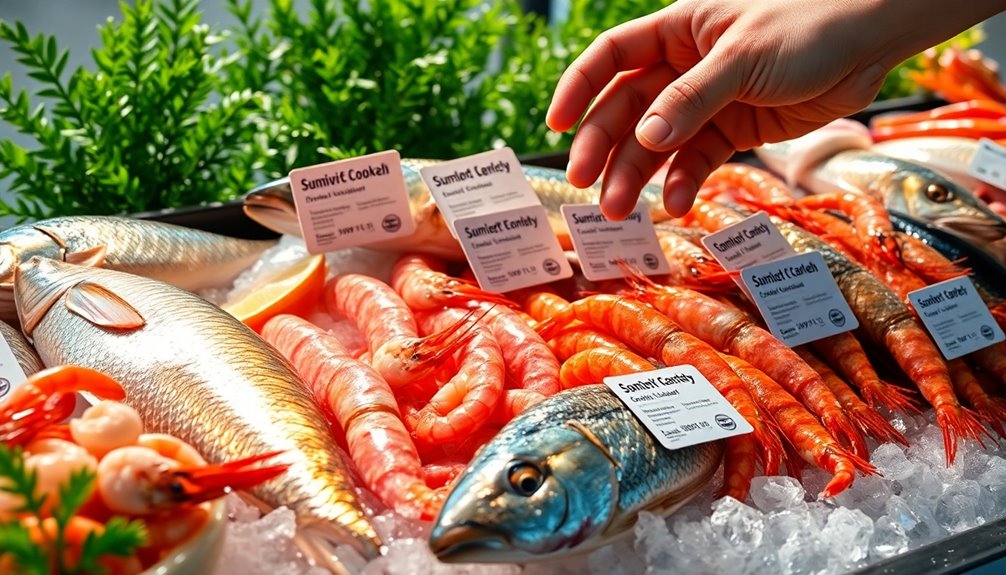When shopping for sustainable seafood, look for eco-labels like MSC or ASC, which indicate responsible sourcing and adherence to sustainability standards. Consider whether the seafood is wild-caught or farmed; both have benefits and challenges but prioritize certifications. Opt for local and seasonal options for fresher flavors and to support local economies. By asking questions about sourcing and being mindful of fishing practices, you can make informed choices that positively impact marine ecosystems. Each decision helps protect biodiversity and contribute to a healthier ocean. Discovering the nuances of sustainability can enhance your shopping experience even further.
Key Takeaways
- Look for eco-labels like MSC and ASC to ensure seafood meets sustainability and ethical sourcing standards.
- Choose seasonal and local seafood options to support fresh flavors and local economies.
- Inquire about the sourcing practices of the seafood to ensure responsible fishing or farming methods.
- Prioritize wild-caught seafood from sustainable fisheries over overfished species to protect marine ecosystems.
- Opt for farmed seafood that follows responsible aquaculture practices to minimize environmental impact.
Understanding Sustainable Seafood
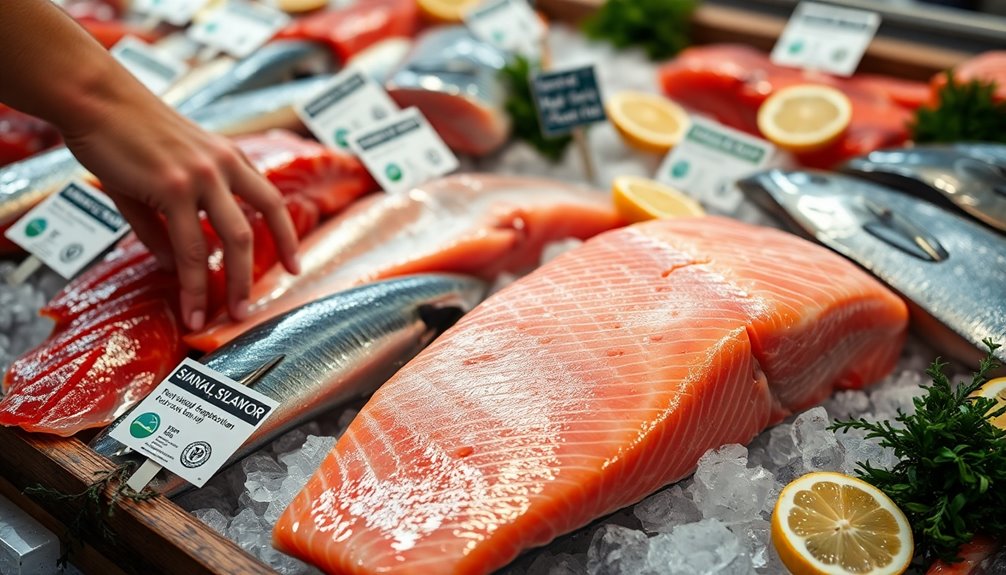
Understanding sustainable seafood is vital for anyone interested in making environmentally responsible choices. When you choose seafood wisely, you contribute to the health of our oceans and support fishing practices that don't deplete fish populations. Overfishing impacts not only the species targeted but also the entire marine ecosystem. By opting for sustainable seafood, you can help counteract these negative effects.
The ocean health is an important concern, as it affects biodiversity, water quality, and the overall balance of marine life. Unsustainable fishing practices often lead to the collapse of fish stocks, disrupting food chains and harming other marine creatures. You might be surprised to learn that some fish species are more vulnerable than others, making it essential to know which options are sustainable.
When you're at the grocery store or a restaurant, take a moment to assess the seafood on the menu or on the shelf. Look for species that are abundant and caught or farmed using methods that protect the ecosystem. By becoming more informed about your seafood choices, you're not just protecting your health; you're also playing a role in the larger movement towards ocean conservation.
Incorporating sustainable seafood into your diet helps foster a sense of community among those who care about environmental issues. Together, you and others can create a positive impact, ensuring the ocean remains a thriving habitat for generations to come. So, next time you shop for seafood, remember that your choices matter.
Eco-Labels to Trust
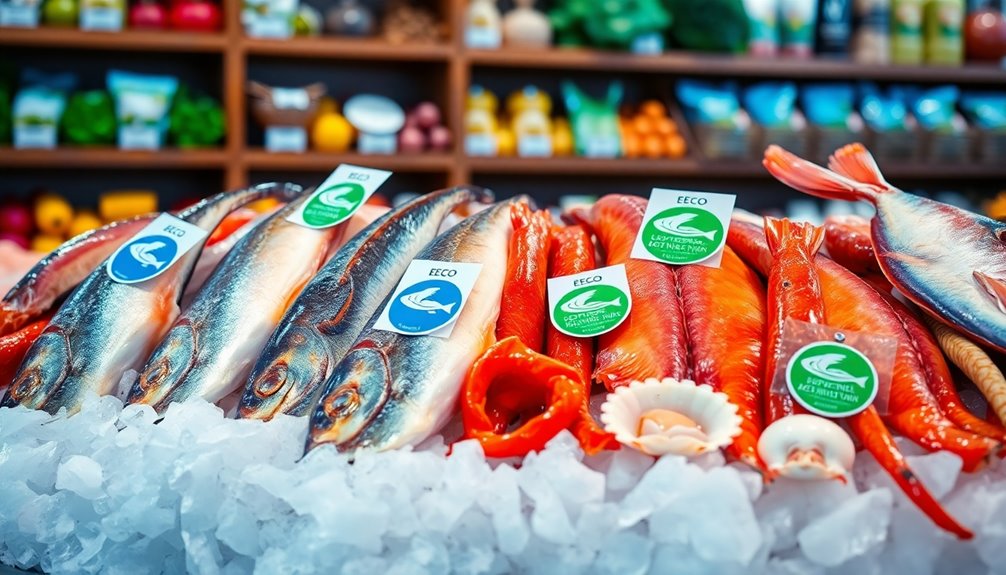
When selecting sustainable seafood, eco-labels serve as your trusted guide. These labels indicate that the product meets specific certification standards designed to guarantee environmental responsibility and fishery sustainability. As a conscious consumer, you want to make choices that align with your values, and eco-labels help you navigate the often-confusing seafood aisle.
Look for certifications from reputable organizations such as the Marine Stewardship Council (MSC) and the Aquaculture Stewardship Council (ASC). These labels signify that the seafood you're buying adheres to rigorous environmental and social criteria.
The MSC focuses on wild-caught fisheries, ensuring that fish populations remain healthy and ecosystems are protected.
The ASC, on the other hand, emphasizes eco-friendly options in aquaculture, promoting responsible farming practices that minimize environmental impact.
Understanding these certification standards can empower you to make informed choices. When you see an eco-label, you can trust that the seafood was sourced sustainably and ethically. This not only supports the health of our oceans but also promotes fair labor practices within the seafood industry. Additionally, engaging with mindfulness meditation can enhance your decision-making process by improving focus and reducing impulsive choices.
As you shop, remember that every decision counts. By choosing seafood with respected eco-labels, you're joining a community of consumers dedicated to sustainability. Together, you can safeguard that future generations can enjoy the beauty and bounty of our oceans.
Wild-Caught vs. Farmed
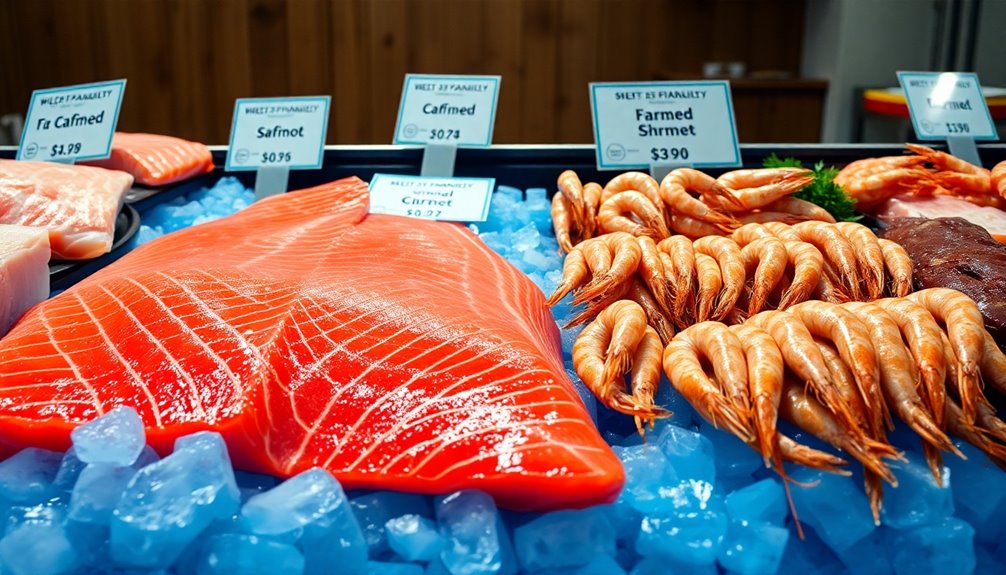
Choosing sustainable seafood involves not just recognizing eco-labels but also understanding the differences between wild-caught and farmed fish. Both options have their pros and cons, and knowing these can help you make informed choices that align with your values and the environment.
Wild-caught fish are typically harvested from their natural habitats, which can mean a lower environmental impact regarding feed use and pollution. However, overfishing can threaten fish populations, disrupting ecosystems and reducing biodiversity. As a consumer, you're part of a larger conversation around sustainability. Your demand for wild-caught fish can encourage responsible fishing practices, but it's crucial to choose species that aren't overexploited.
On the other hand, farmed fish are raised in controlled environments. While they can alleviate pressure on wild populations, they often come with their own set of challenges. Intensive farming can lead to water pollution and disease transmission, affecting surrounding ecosystems. However, advancements in aquaculture practices are making some farmed fish more sustainable. By selecting farmed fish from responsible sources, you can support better environmental practices and consumer demand for sustainable options. Furthermore, just like mini bands can provide effective results with minimal time commitment, choosing sustainable seafood can lead to positive impacts on both your health and the environment by promoting responsible fishing practices.
Seafood Sourcing Practices
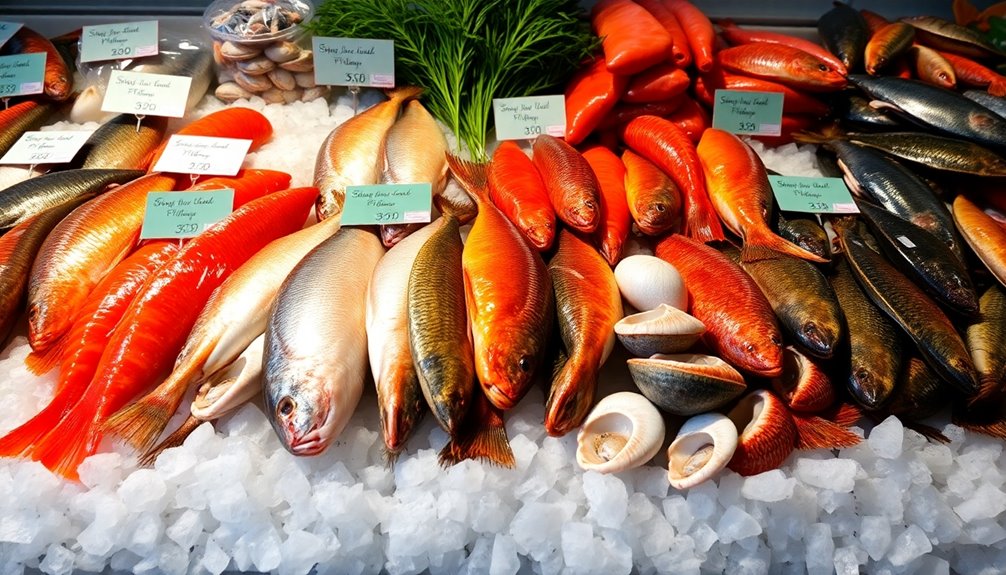
Sourcing seafood responsibly involves navigating a complex web of practices that impact both the environment and the communities that depend on ocean resources. When you walk into a store, it's essential to recognize the importance of ethical fishing practices. These practices guarantee that fish populations remain healthy, ecosystems stay balanced, and the livelihoods of fishing communities are preserved.
To make informed choices, look for seafood that comes from traceable supply chains. Traceability helps you understand where your seafood comes from and how it was harvested. It's not just a buzzword; it's a commitment to transparency that holds producers accountable. By choosing seafood with a traceable supply chain, you support businesses that prioritize sustainability over profit.
When evaluating seafood options, consider certifications such as the Marine Stewardship Council (MSC) or the Aquaculture Stewardship Council (ASC). These certifications indicate adherence to rigorous standards in ethical fishing and sustainable farming practices. By opting for certified seafood, you're not just making a personal choice; you're joining a collective effort to support ocean health and the communities that rely on it. This commitment to sustainability parallels the principles of comprehensive strengthening found in effective core programs.
Ultimately, choosing responsibly sourced seafood fosters a sense of belonging to a community that cares about the planet. Your choices have the power to influence market demand, encouraging more retailers and producers to adopt sustainable practices. Together, we can contribute to a healthier ocean and a more equitable seafood industry.
Seasonal and Local Options
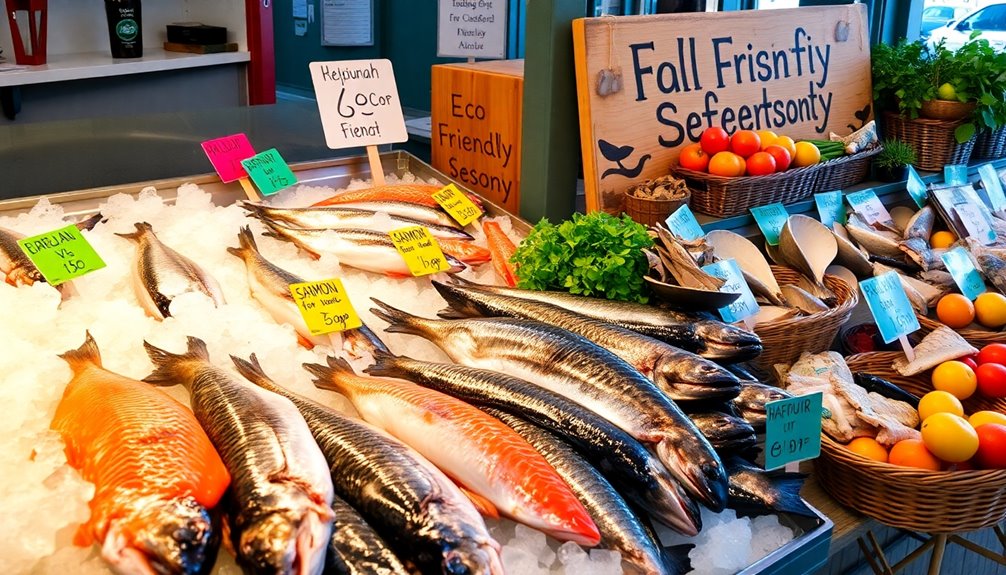
Opting for seasonal and local seafood not only enhances your culinary experience but also supports sustainability efforts and local economies. When you choose seafood that's in season and sourced from nearby waters, you're tapping into the natural rhythms of the environment. This means fresher flavors and better quality, as the seafood hasn't traveled long distances.
By embracing seasonal seafood, you also foster community supported practices. Many local fisheries and aquaculture farms rely on strong relationships with consumers. By purchasing from them, you're not just buying a product; you're investing in farmer partnerships that prioritize sustainable methods. This creates a more resilient local economy and encourages the use of responsible fishing practices, which is vital for maintaining fish populations.
Moreover, when you engage with your local seafood community, you often gain access to unique species that aren't available in larger grocery stores. This variety can inspire creativity in your cooking and deepen your connection to the region's natural bounty. You may even find opportunities to learn from local fishermen and farmers about their practices and challenges, enriching your understanding of the food system.
In essence, choosing seasonal and local seafood makes you a part of a larger movement toward sustainability and community health. It's a choice that resonates with others who value transparency, quality, and the importance of supporting those who work diligently to provide fresh, healthy options. Additionally, incorporating plant-based options into your meals can further enhance your commitment to sustainability. So next time you're at the store or market, look for what's in season and sourced locally. You'll be making a difference on multiple levels.
Frequently Asked Questions
How Can I Tell if Seafood Is Fresh?
When you're checking if seafood's fresh, look for clear, bright eyes and shiny skin. Smell it; fresh seafood shouldn't have a strong fishy odor. Pay attention to the texture—firm is best.
If you're buying, consider market options that prioritize quality. Remember to ask about storage tips, too. Keeping it cold until you cook can make a huge difference.
These buying tips will help you feel confident in your seafood choices!
What Are the Environmental Impacts of Overfishing?
You might think overfishing only affects fish populations, but its impact stretches far beyond that. When fish are overharvested, marine biodiversity suffers, disrupting entire ecosystems. The loss of species can lead to economic consequences for communities reliant on fishing. Healthy oceans are crucial for sustaining livelihoods and maintaining balance in nature. By understanding these connections, you can appreciate the importance of supporting sustainable fishing practices that protect both the environment and your local economy.
Are There Specific Seafood Species I Should Avoid?
When choosing seafood, you should avoid species known for high mercury levels, like shark and swordfish, as they can pose health risks. Also, consider bycatch concerns; overfishing not only depletes target species but also threatens other marine life caught unintentionally.
How Does Seafood Transportation Affect Sustainability?
Imagine seafood traveling from ocean depths to your plate like a long, winding river. This journey impacts sustainability greatly. Seafood transport contributes to its carbon footprint, with emissions rising as the distance increases.
Can I Eat Seafood While Pregnant or Breastfeeding?
Yes, you can eat seafood while pregnant or breastfeeding, but focus on seafood safety. Opt for low-mercury options like salmon or shrimp, which provide essential nutrients for you and your baby. These fish are rich in omega-3 fatty acids, supporting brain development.
Avoid high-mercury species like shark or swordfish. Balancing nutritional benefits with caution guarantees you nourish your child while enjoying seafood, creating a healthy bond through shared meals.
Conclusion
When it comes to choosing sustainable seafood, remember, "you are what you eat." By understanding eco-labels, weighing the benefits of wild-caught versus farmed options, and considering local and seasonal selections, you're not just making a meal – you're making a difference. Every choice counts in protecting our oceans and ensuring future generations can enjoy seafood too. So, next time you're at the store, let your conscience guide you toward more sustainable options. Your plate can be part of the solution!

